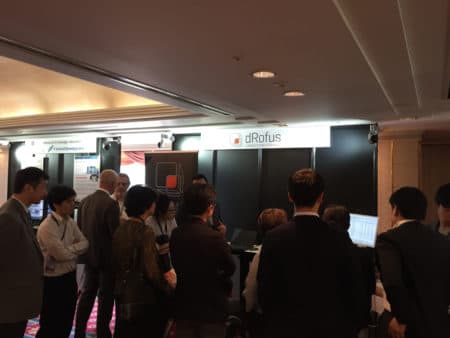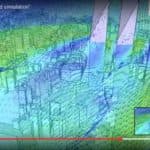At GRAPHISOFT’s Key Client Conference in Kyoto, Japan, in late May, the BIM leader had over a dozen exhibitor companies in attendance to talk to conference attendees about their AEC software and BIM-related solutions. Also in attendance at the event were large multinationals in the hardware arena serving the AEC market, such as Dell, Fujitsu, HP and Nvidia.
While there were some interesting items of note from the multinational hardware companies mentioned above—and I’ll get to one very interesting one from HP at the bottom of this article—the focus of below is squarely on the software companies largely serving the Asian AEC markets. One final note before we look into some of these companies. All of the exhibitors took to the conference stage on day one to discuss their companies, services, and products for the AEC market. This wetted the appetites of KCC attendees and press alike to visit their booths during conference session break periods.
Exhibitors of Interest
AKL FlowDesigner
Advanced Knowledge Laboratory, Inc., is the maker of AKL FlowDesigner, a computational fluids dynamics (CFD) software aimed at the AEC industry. The purpose of this software is to visualize wind flow and temperature distribution, something not easily understood as to its effects on buildings, but vitally important with large or complex structures and especially in urban sites where complex wind flows are generated by nearby buildings.
AKL FlowDesigner has many uses for architects and urban designers, including air flow analysis in urban environments, air conditioning analysis of arenas, indoor condensation analysis, ventilation duct heating analysis, among many others. Models of buildings and environments can be imported into this CFD software using formats such as IFC for BIM models, SketchUp, STL, and 3DS formats. The Japanese made software is aiming to democratize a typically complex piece of engineering software. It simplifies the application of this technology, helping architects bring analysis technology to the front-end of the design process so they can iterate designs in response to the impacts of wind flow.

02 – Screenshot of FlowDesigner showing simulation of AC cooling system large space. (image: screenshot of YouTube video)
I saw something like this years ago at AIA National Convention, by Altair Corporation, but it was a demo and not a shipping product yet for architecture. AKL FlowDesigner is today a shipping product for architects. ARCHICAD architects can import their building designs into AKL FlowDesigner using IFC and run numerous analyses and simulations. Moreover, given the strong connection between ARCHICAD and Rhino and Grasshopper, it is worth noting that there is a new Grasshopper component of FlowDesigner as well. To learn more, you can visit them here.
smartCON Planner
Another interesting piece of software is smartCON Planner, developed by Kajima Corporation and distributed and supported by another exhibitor named Doalltech, an AEC solutions provider. smartCON Planner is software for the construction side of the AEC world; it’s for general contractors and other building professionals. Kajima itself is one of the world’s largest construction companies and one of the top 5 largest construction companies in Japan.
smartCON Planner helps eliminate errors by visualizing the construction process itself via 3D models. It works inside ARCHICAD itself and therefore is technically add-on software to the core BIM application. The best way to quickly understand what smartCON Planner does, however, is through watching a demo movie (see below).
smartCON Planner is pretty amazing and helps builders visualize and plan scaffolding, crane lift operations, earth anchor placement, and road deck placement, among other things. It comes loaded with 3D model elements of items builders use in construction for these operations and processes, thereby enabling them to plan and visualize the construction workflow to find and troubleshoot problems virtually, which is so much cheaper than troubling-shooting construction issues in real-time on the job site.
Doalltech is a Korean company and is the distributor of smartCON Planner.
dRofus
dRofus was also an exhibitor at the 2017 KCC in Kyoto and is the newest subsidiary of the Nemetschek Group in Germany. dRofus is a planning and data management tool squarely focused on the “I” in BIM. The application is particularly strong in architecture segments like hospitals and airports. Darren Tims, a principal at HDR | Rice Daubney, Australia, a presenter at the KCC, also discussed his firm’s use of dRofus and praised it for its unique capabilities.
dRofus is a database application, principally. Data can sync between it and BIM tools like Revit and ArchiCAD and run bi-directionally. dRofus also supports IFC workflows. The program features four modules: (1) Rooms, (2) Room Data Sheets, (3) Items, and (4) Systems. The first module is fundamentally an aid in the architectural brief or architectural programming development. Owners, owner reps, users, and the architects and planners can drop in information in the Rooms module, while the “Room Data Sheets” add even more information to specific rooms using a data sheet format which is fully customizable.

04 – dRofus is the latest Nemetschek Group company and was a key exhibitor in Kyoto. Due to several presenters discussing the use of dRofus, the company attracted many visitors to its booth.
“Items” is the third module and helps the user organize FF&E, services, door, window and finishes data and is again, bi-directionally linked to the Building Information Modell (BIM). “Systems” as the fourth module helps organize all data related to components in the MEP and engineering and technical environments. This module is currently only available in Scandinavian versions, but an international version is underway.
To learn more about dRofus visit them here on the web.
next page: More ARCHICAD Third-Party Apps, Rebro 2016, and Something Special From HP





Reader Comments
Comments for this story are closed